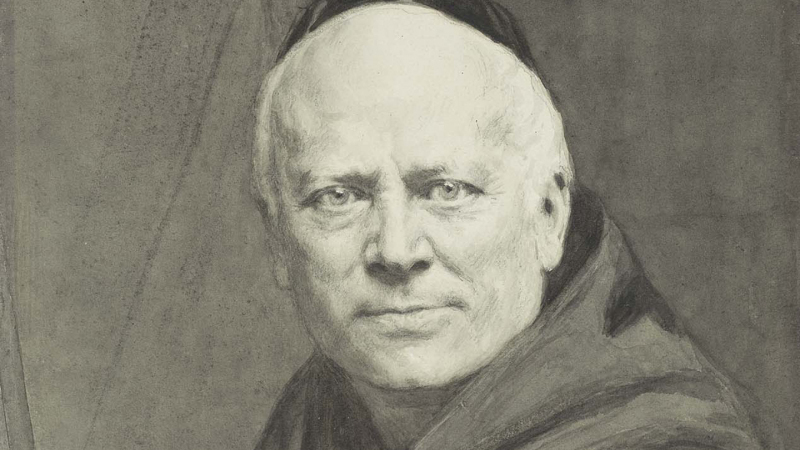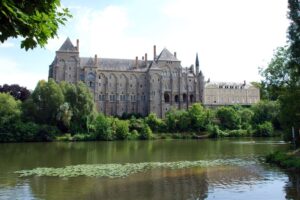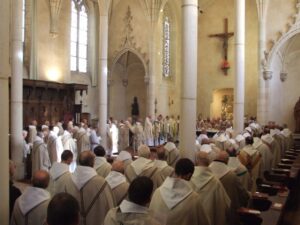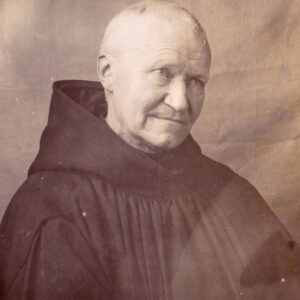
Servant of God Prosper Guéranger was a Benedictine monk, priest, abbot and reformer. Prosper was born in 1805 to Pierre Guéranger, the head of a small school for boys, and his wife. They lived in the town of Sable in western France. Young Prosper became an avid reader at a young age, and was greatly influenced by reading two works of Francois Rene Chateaubriand: The Genius of Christianity and The Martyrs. These books had been recently published and were an antidote to the popularity of the anti-religious Enlightenment that had been embraced by cultural elites. In order to understand Prosper Guéranger’s life, it is important to know that the Church in France during the French Revolution had been all but exterminated. Monastic life was almost wiped out. Church property became owned by the state, hundreds of priests put to death, tens of thousands more deported. The reign of self-appointed Emperor Napoleon Bonaparte was not much better, including his imprisonment of Pope Pius VII for five years. As a seven-year-old, when Prosper heard of the Pope’s imprisonment, he was distressed.
THE COUNTER-REVOLUTION
As a teen, he was especially influenced by the writings of Joseph de Maistre, an important figure in the counter-Enlightenment. Discerning a call to the priesthood, Prosper began studies for the Le Mans diocese in 1822. As a seminarian, he was presented with “absolutely no course in ecclesiastical history, liturgy or canon law, absolutely no mystic or aesthetic theology…and very little godliness.” It was his own private studies that were his best formation. He was especially drawn to the history of monasticism and the Rule of St. Benedict. He was ordained in 1827. On that same day, he went to walk around the grounds of the ruins of the Abbey of Marmoutiers, which had been founded by the great fourth-century pioneer of western monasticism, St. Martin of Tours. There, he encountered an elderly woman who had been a witness to the monastery’s destruction and who retold the story of the smashing of the stained glass windows.
Father Guéranger was named a canon for the Cathedral Chapter of Tours. His bishop gave him permission to use the Roman Missal and breviary in place of the unique-to-France Gallican missal, which was separated from the universality of the ancient Roman Canon. He continued studying and published two important essays about the significance and beauty of the liturgy.
A GREAT OPPORTUNITY

He discovered in an advertisement that the decayed monastery of Solesmes, which had been used as a warehouse during the Revolution, was for sale. He saw this as an opportunity to restore to France a center of study, consecrated life, and beautiful liturgy. With the support of his bishop and private donations, he purchased the property and moved in with four other priests in the summer of 1833. In 1837, Pope Gregory XVI raised the status of the monastery to Abbey, made it the motherhouse for the Benedictines in France and appointed Father Guéranger as abbot. This was most impressive, considering that he had never received monastic formation. Father Guéranger pronounced his vows in Rome shortly after the pronouncement.
In addition to serving as Father Abbot, Prosper continued his writing and his studies of the Church Fathers.
BRILLIANCE USED FOR GOOD

His magnum opus was The Liturgical Year, a 15-volume set which was a much-needed explanation of the Mass and why it is done the way it is, the various Church feasts, and the lives of the saints. He also wrote The Memoir of the Immaculate Conception, in which he explains the logic of this long-held belief of the Virgin Mary’s sinlessness from her very conception. Several years later, he served as a consultant for Pope Pius IX in writing the 1854 dogmatic teaching on the Immaculate Conception. He also wrote in support of the dogma of Papal Infallibility and spoke at the First Vatican Council in 1870, explaining the witness of the Church Fathers for this important, but often misunderstood truth. In his later years, he labored at length to restore Gregorian Chant from disuse, which was reinforced by the Second Vatican Council’s declaration in Sacrosanctum Concilium that it be given “pride of place” in all liturgies. He co-founded the Abbey of St. Cecile near Solesmes, creating a foundation for women Benedictines in France. Dom Guéranger died on January 30, 1875 at age sixty-nine. His remains are buried at the Solosmes crypt, with his heart venerated at nearby St. Cecile.

“LEX ORANDI, LEX CREDENDI, LEX VIVENDI”
Dom Prosper Guéranger was painfully aware of the grievous severance of his country from its rich Catholic history and the resulting spiritual lethargy. He spent his entire life laboring to restore the Catholic Faith in France and its vital relationship with the Holy See. He recognized that it is in the liturgy – the Holy Sacrifice of the Mass – that culture can be vitalized, for “Lex orandi, lex credendi, lex vivendi” (the law of what is prayed [is] what is believed [is] the law of what is lived). He knew how important it is for the Mass to be offered properly and understood by the faithful. Although having experienced no monastic formation, he was a living example for his monks. Indeed, Pope [Blessed] Pius IX wrote of him, “By his virtue, piety, zeal, knowledge, and by the work of a lifetime, he showed himself to be a true disciple of St. Benedict and a perfect monk”. The Diocese of Le Mans, France opened a cause for his eventual beatification in 2005, which being accepted for consideration by the Vatican, gives him the title Servant of God.
